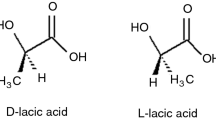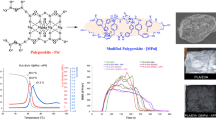Abstract
A variety of poly(lactic acid) (PLA)-poly(ε-caprolactone) (PCL) samples with different PLA:PCL ratios, containing different contents of graphite nanoplatelets (GrP), were analysed in a thermogravimetric analyser (TG) under, respectively, nitrogen and oxygen atmospheres, and in a differential scanning calorimeter (DSC) in a nitrogen atmosphere. Their respective morphologies were determined through scanning electron microscopy. The TG analyses in nitrogen gave fairly predictable results, but the analyses in oxygen gave complex results that seemed to be dependent on the respective morphologies of the blend samples and on the presence and amount of GrP in the respective samples. It was observed that, depending on the blend or nanocomposite morphologies, the GrP could have played the role of catalysing the degradation process, or inhibiting the onset of degradation by immobilizing the polymer or free radical chains and by delaying the evolution of the degradation products from the respective samples. The DSC results clearly showed the influence of the respective components in the blends and composites on the crystallization behaviour and crystallinities of the two polymers.







Similar content being viewed by others
References
Ikada Y, Tsuji H. Biodegradable polyesters for medical and ecological applications. Macromol Rapid Commun. 2000;21:117–32.
Delpouve N, Delbreilh L, Stoclet G, Saiter A, Dargent E. Structural dependence of the molecular mobility in the amorphous fractions of polylactide. Macromolecule. 2014;47:5186–97.
Woodruff MA, Hutmacher DW. The return of a forgotten polymer: polycaprolactone in the 21st century. Progr Polym Sci. 2010;35:1217–56.
Chen B, Evans JRG. Poly(ε-caprolactone)—clay nanocomposites: structure and mechanical properties. Macromolecules. 2006;39:747–54.
Darie RN, Pâslaru E, Sdrobis A, Pricope GM, Hitruc GE, Poiată A, Baklavavaridis A, Vasile C. Effect of nanoclay hydrophilicity on the poly(lactic acid)/clay nanocomposites properties. Ind Eng Chem Res. 2014;53:7877–90.
Khunova V, Kelnar I, Kristof J, Dybal J, Kratochvíl J, Kaprálková L. The effect of urea and urea-modified halloysite on performance of PCL. J Therm Anal Calorim. 2015;120:1283–91.
Neppalli R, Marega C, Marigo A, Bajgai MP, Kim HY, Causin V. Improvement of tensile properties and tuning of the biodegradation behavior of polycaprolactone by addition of electrospun fibres. Polymer. 2011;52:4054–60.
Li Y, Shimizu H. Toughening of polylactide by melt blending with a biodegradable poly(ether)urethane elastomer. Macromol Biosci. 2007;7:921–8.
Yeh JT, Wu CJ, Tsou CH, Chai WL, Chow JD, Huang CJ, Chen KN, Wu CS. Study on the crystallization, miscibility, morphology, properties of poly (lactic acid)/poly(ε-caprolactone) blends. Polym Plast Technol Eng. 2009;48:571–8.
Urquijo J, Guerrica-Echevarría G, Eguiazábal JI. Melt processed PLA/PCL blends: effect of processing method on phase structure, morphology, and mechanical properties. J Appl Polym Sci. 2015;132:42641.
López-Rodríguez N, López-Arraiz A, Meaurio E, Sarasua JR. Crystallization, morphology, and mechanical behavior of polylactide/poly(ε-caprolactone) blends. Polym Eng Sci. 2006;46:1299–308.
Na YH, He Y, Shuai X, Kikkawa Y, Doi Y, Inoue Y. Compatibilization effect of poly(ε-caprolactone)-b-poly(ethylene glycol) block copolymers and phase morphology analysis in immiscible poly(lactide)/poly(ε-caprolactone) blends. Biomacromolecules. 2002;3:1179–86.
Tuba F, Olah L, Nagy P. Characterization of reactively compatibilized poly (d, l-lactide)/poly(ε-caprolactone) biodegradable blends by essential work of fracture method. Eng Fract Mech. 2011;78:3123–33.
Gelfer MY, Song HH, Liu L, Hsiao BS, Chu B, Rafailovich M, Si M, Zaitsev V. Effects of organoclays on morphology and thermal and rheological properties of polystyrene and poly(methyl methacrylate) blends. J Polym Sci B. 2003;41:44–54.
Kelnar I, Sukhanov V, Rotrekl J, Kaprálková L. Toughening of recycled poly(ethylene terephthalate) with clay-compatibilized rubber phase. J Appl Polym Sci. 2010;116:3621–8.
Rotrekl J, Sikora A, Kaprálková L, Dybal J, Kelnar I. Effect of an organoclay on the reaction-induced phase-separation in a dynamically asymmetric epoxy/PCL system. eXPRESS Polym Lett. 2013;7:1012–9.
Bhattacharya SN, Gupta RK, Kamal MR. Polymeric nanocomposites. Munich: Hanser; 2008.
Ray SS, Pouliot S, Bousmina M, Utracki LA. Role of organically modified layered silicate as an active interfacial modifier in immiscible polystyrene/polypropylene blends. Polymer. 2006;45:8403–13.
Shi YY, Zhang WB, Yang JH, Huang T, Zhang N, Wang Y, Yuan GP, Zhang CL. Super toughening of the poly (l-lactide)/thermoplastic polyurethane blends by carbon nanotubes. RSC Adv. 2013;3:26271–82.
Jain S, Reddy MM, Mohanty AK, Misra M, Ghosh AK. A new biodegradable flexible composite sheet from poly(lactic acid)/poly(ε-caprolactone) blends and micro-talc. Macromol Mater Eng. 2010;295:750–62.
Kelnar I, Kratochvíl J, Fortelný I, Kaprálková L, Zhigunov A, Kotrisová M, Khunová V, Nevoralová M. Influence of clay-nanofiller geometry on the structure and properties of poly(lactic acid)/thermoplastic polyurethane nanocomposites. RSC Adv. 2016;6:30755–62.
Hasook A, Tanoue S, Iemoto Y, Unryu T. Characterization and mechanical properties of poly(lactic acid)/poly(ε-caprolactone)/organoclay nanocomposites prepared by melt compounding. Polym Eng Sci. 2006;46:1001–7.
Potts JR, Dreyer DR, Bielavski CW, Ruoff RS. Graphene-based polymer nanocomposites. Polymer. 2011;52:5–25.
Cao Y, Zhang J, Feng J, Wu P. Compatibilization of immiscible polymer blends using graphene oxide sheets. ACS Nano. 2011;5:5920–7.
Hua L, Kai W, Inoue Y. Synthesis and characterization of poly(ε-caprolactone)–graphite oxide composites. J Appl Polym Sci. 2007;106:1880–4.
Kelnar I, Kratochvíl J, Kaprálková L, Zhigunov A, Nevoralová M. Graphite nanoplatelets-modified PLA/PCL: effect of blend ratio and nanofiller localization on structure and properties. J Mech Behav Biomed Mater. 2017;71:271–8.
Forouharshad M, Gardella L, Furfaro D, Galimberti M, Monticelli O. A low-environmental-impact approach for novel bio-composites based on PLLA/PCL blends and high surface area graphite. Eur Polym J. 2015;70:28–36.
Kelnar I, Kratochvíl J, Fortelný I, Kaprálková L, Zhigunov A, Nevoralová M. Effect of graphite nanoplatelets on melt drawing and properties of PCL/PLA microfibrillar composites. Polym Compos. 2017. https://doi.org/10.1002/pc.24322.
Eng CC, Ibrahim NA, Zainuddin N, Ariffin H, Yunus WMZW, Then YY, The CC. Enhancement of mechanical and thermal properties of polylactic acid/polycaprolactone blends by hydrophilic nanoclay. Indian J Mater Sci. 2013; Article ID 816503.
Botlhoko OJ, Ramontja J, Ray SS. Thermal, mechanical, and rheological properties of graphite- and graphene oxide-filled biodegradable polylactide/poly(ɛ-caprolactone) blend composites. J Appl Polym Sci. 2017;45373:134–40.
Mofokeng JP, Luyt AS. Morphology and thermal degradation studies of melt-mixed poly(lactic acid) (PLA)/poly(ε-caprolactone) (PCL) biodegradable polymer blend nanocomposites with TiO2 as filler. Polym Test. 2015;45:93–100.
Mofokeng JP, Luyt AS, Kelnar I. Effect of layered silicates on the thermal stability of PCL/PLA microfibrillar composites. Polym Test. 2016;50:9–14.
Luyt AS, Kelnar I. Effect of halloysite nano tubes on the thermal degradation behaviour of PCL/PLA microfibrillar composites. Polym Test. 2017;60:166–72.
Vogel C, Siesler HW. Thermal degradation of poly(ε-caprolactone), poly(l-lactic acid) and their blends with poly(3-hydroxy-butyrate) studied by TGA/FT-IR spectroscopy. Macromol Symp. 2008;265:183–94.
Acknowledgements
This work was supported by Czech Science Foundation (Grant No: 16-03194S).
Author information
Authors and Affiliations
Corresponding author
Rights and permissions
About this article
Cite this article
Luyt, A.S., Kelnar, I. Effect of blend ratio and nanofiller localization on the thermal degradation of graphite nanoplatelets-modified PLA/PCL. J Therm Anal Calorim 136, 2373–2382 (2019). https://doi.org/10.1007/s10973-018-7870-y
Received:
Accepted:
Published:
Issue Date:
DOI: https://doi.org/10.1007/s10973-018-7870-y




